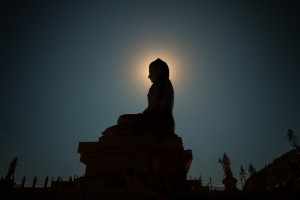
The Buddhist tradition uses a three-step model for the development of insight/wisdom. While it could be applied to nearly anything, we’re mostly interested in how it applies to the three meditative truths: inconstancy, not-self and dukkha.
Although, to bring it down to earth, imagine we really dislike cold weather. Whenever it drops below zero, we automatically become tense, agitated and grumpy.
In other words, our experience is of “dukkha”—the pain of wanting things to be other than they are.
However, after walking through the three steps detailed below, we learn to be in frigidly cold weather without getting tense or resistant. And, in turn, we actually feel a deep capacity to stay relaxed and engaged, not just during cold weather, but during just about all unpleasant life situations.
In this post, I’ll explain the mechanics of how this process unfolds.
 Step One — Information Gathering
Step One — Information Gathering
Initially, this usually happens through reading, listening to talks and having conversations.
After reading a number of spirituality and self-help books, we might notice that one of the basic messages is to let go, be content and accept whatever is happening. Maybe we talk about this with other people, and see if they’ve had any experiences of radical acceptance.
The readings and talks heighten our awareness, and then we begin to collect experiential information.
We might start vividly noticing when we’re in a state of resistance, and when we’re in a state of acceptance. We notice what each of those states feels like.
Maybe we even notice the difference between what we’re feeling, like freezing cold, and our reaction to what we’re feeling, like accepting/resisting.
We just keep collecting raw data on our actual experience.
 Step Two — Contemplation, Reflection and Inner Processing
Step Two — Contemplation, Reflection and Inner Processing
In this stage, we start engaging with the raw data and asking questions.
We might explore questions like, “what is happiness?” or “is it possible to be happy even when unpleasant things are happening, like the intense cold?”
Or perhaps we reflect on our past experiences. Say, while on a three block walk in the cold, we got snippy with our friend, and later on reflect, “do I like how I acted before? What could I have done differently?”
It often helps to do this deeper thinking more formally, like through journaling or with a therapist/mentor/good friend. However, it could also happen in our own mind.
The more we reflect this way, the more our subconscious begins to do “inner processing” all on its own. This could come through dreams, when creating art, or through random “deep” thoughts that emerge from silence.
This stage is like the “unseen movement” of tectonic plates that happens before the earthquake.
As an aside, it’s currently fashionable to say that meditation is anti-thought. It has us believe that we only need to maintain present moment awareness, and everything else takes care of itself. In reality, contemplation is actually a tremendous aid along the path. The challenge is being able to use it very efficiently and intentionally, rather than just compulsively thinking all the time.
 Step Three — Experiential Insight
Step Three — Experiential Insight
On a brisk February evening, we’re walking a couple blocks outdoors. The wind thrashes our face, and our toes sting of numbness. We clench our muscles and hurry along as quickly as possible.
Suddenly, amidst much inner tension, something occurs to us in a fuller way than ever before: I could just let go.
We instantly release our muscles, and also our inner resistance to it. We begin walking at a normal pace and let out a little chuckle. Our mood has dramatically shifted from agitation to peacefulness. The cold is still piercing, but it no longer seems like a big deal.
What just happened was an insight into dukkha—how suffering comes through wanting things to be other than they are.
It’s important to note that this insight was an actual experience that happened in real-time, and tangibly changed both our understanding, and our way of being.
In part 2, I described how insight was like a mind-earthquake.
It’s as if all the information and inner processing percolates in the undercurrents of mind, like tectonic plates that slowly build up tension. Then, when the tension gets strong enough, an insight happens.
Sometimes we develop wisdom through dozens if not thousands of mini-insights that slowly create shifts in us over time—like a thousand 2.0 magnitude insights. Other times, we have one big insight that feels so deep and penetrative that it forever changes how we show up in the world—like an 8.0 magnitude insight.
If the above example were a very mild insight into dukkha, like a 1.0, it would probably just be a thought-in-our-head, and only provide intellectual relief.
If it were a moderate insight into dukkha, like a 5.0, it could have the power to forever alter our relationship with cold weather.
However, if it penetrated more deeply, like an 8.0, the insight wouldn’t just be towards one unpleasant situation, like the cold, but towards all situations. We would very deeply understand how to “let go” of any resistance, and thereby begin to live with a profound sense of inner freedom.
 Summary
Summary
If we strip away all the fancy explanations, everyone has some sense of what an insight is. It’s a very common human experience.
Really, we have mini-insights quite often, even just psychological insights like realizing that it’s best to take the trash out the night before, rather than in the morning.
Although, my primary interest in deconstructing insight is about helping people develop meditative-insight-that-leads-to-inner freedom.
In turn, this series of posts is offering “information,” and suggesting some points for deeper reflection. I hope to get these topics “percolating” in your subconscious.
From there, add a committed meditation practice, and you’re on your way to inner freedom!
- Introducing Insight and Wisdom in Mindfulness Meditation (Part 1)
- How to Measure the Strength of an Insight (Part 2)
- The Difference between “Psychological” and “Meditative” Insight (Part 3)
- The Three Core Insights of Mindfulness Meditation (Part 4)
- How to Attain Wisdom & Insight in Three Steps (Part 5)
- Six Important Things to Know after a Major Insight (Part 6)
